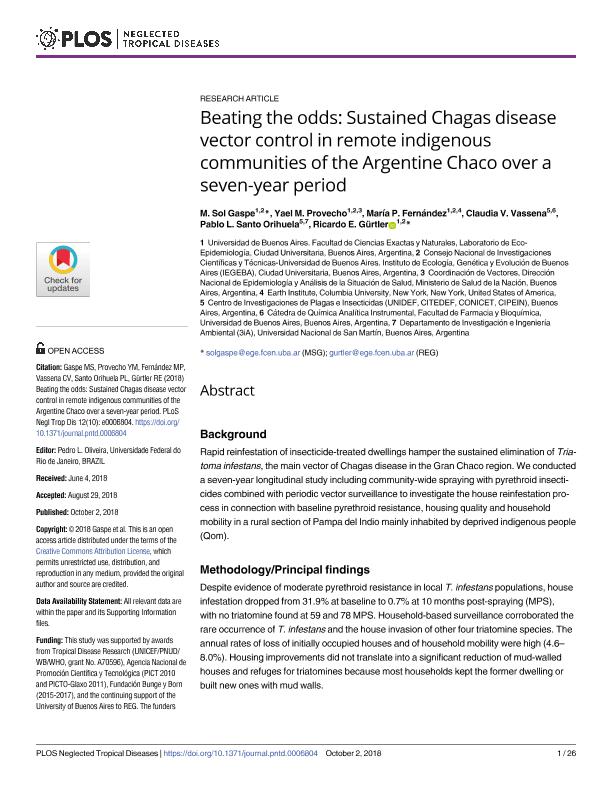Artículo
Beating the odds: Sustained Chagas disease vector control in remote indigenous communities of the Argentine Chaco over a seven-year period
Gaspe, Maria Sol ; Provecho, Yael Mariana
; Provecho, Yael Mariana ; Fernández, María P.; Vassena, Claudia Viviana
; Fernández, María P.; Vassena, Claudia Viviana ; Santo Orihuela, Pablo Luis
; Santo Orihuela, Pablo Luis ; Gurtler, Ricardo Esteban
; Gurtler, Ricardo Esteban
 ; Provecho, Yael Mariana
; Provecho, Yael Mariana ; Fernández, María P.; Vassena, Claudia Viviana
; Fernández, María P.; Vassena, Claudia Viviana ; Santo Orihuela, Pablo Luis
; Santo Orihuela, Pablo Luis ; Gurtler, Ricardo Esteban
; Gurtler, Ricardo Esteban
Fecha de publicación:
10/2018
Editorial:
Public Library of Science
Revista:
Neglected Tropical Diseases
ISSN:
1935-2735
Idioma:
Inglés
Tipo de recurso:
Artículo publicado
Clasificación temática:
Resumen
BACKGROUND: Rapid reinfestation of insecticide-treated dwellings hamper the sustained elimination of Triatoma infestans, the main vector of Chagas disease in the Gran Chaco region. We conducted a seven-year longitudinal study including community-wide spraying with pyrethroid insecticides combined with periodic vector surveillance to investigate the house reinfestation process in connection with baseline pyrethroid resistance, housing quality and household mobility in a rural section of Pampa del Indio mainly inhabited by deprived indigenous people (Qom). METHODOLOGY/PRINCIPAL FINDINGS: Despite evidence of moderate pyrethroid resistance in local T. infestans populations, house infestation dropped from 31.9% at baseline to 0.7% at 10 months post-spraying (MPS), with no triatomine found at 59 and 78 MPS. Household-based surveillance corroborated the rare occurrence of T. infestans and the house invasion of other four triatomine species. The annual rates of loss of initially occupied houses and of household mobility were high (4.6-8.0%). Housing improvements did not translate into a significant reduction of mud-walled houses and refuges for triatomines because most households kept the former dwelling or built new ones with mud walls. CONCLUSIONS/SIGNIFICANCE: Our results refute the assumption that vector control actions performed in marginalized communities of the Gran Chaco are doomed to fail. The larger-than-expected impacts of the intervention program were likely associated with the combined effects of high-coverage, professional insecticide spraying followed by systematic vector surveillance-and-response, broad geographic coverage creating a buffer zone, frequent housing replacement and residential mobility. The dynamical interactions among housing quality, mobility and insecticide-based control largely affect the chances of vector elimination.
Archivos asociados
Licencia
Identificadores
Colecciones
Articulos(IEGEBA)
Articulos de INSTITUTO DE ECOLOGIA, GENETICA Y EVOLUCION DE BS. AS
Articulos de INSTITUTO DE ECOLOGIA, GENETICA Y EVOLUCION DE BS. AS
Articulos(UNIDEF)
Articulos de UNIDAD DE INVESTIGACION Y DESARROLLO ESTRATEGICOS PARA LA DEFENSA
Articulos de UNIDAD DE INVESTIGACION Y DESARROLLO ESTRATEGICOS PARA LA DEFENSA
Citación
Gaspe, Maria Sol; Provecho, Yael Mariana; Fernández, María P.; Vassena, Claudia Viviana; Santo Orihuela, Pablo Luis; et al.; Beating the odds: Sustained Chagas disease vector control in remote indigenous communities of the Argentine Chaco over a seven-year period; Public Library of Science; Neglected Tropical Diseases; 12; 10; 10-2018; 1-26
Compartir
Altmétricas



